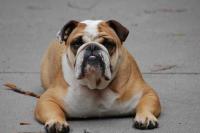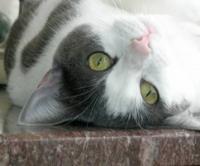Dog and Cat Constipation
Dog and cat constipation can be a minor discomfort or severe enough to be potentially life threatening. Your pet will be uncomfortable and won’t feel well.
CAUTION: If your pet is a male cat and he’s in the litter box straining, take him to your vet immediately. He may not be constipated but, rather, he can’t urinate. This can be life threatening.
Causes of Constipation in Pets
An occasional bout of constipation in pets can be caused by eating the wrong thing. Many years ago, I saw a dog that became impacted after eating bones. This means that the there is a solid block of stool that is stuck. Long-lasting dog and cat constipation can also lead to this.
A change in diet or drinking less water can also cause dog and cat constipation. Some drugs can be the reason. Check with your vet if your pet has recently started a new medicine. Occasionally some other medical problems will cause a constipated cat or dog. Many times, we don’t really know why it has happened.
Cats (rarely dogs) can develop a condition called megacolon. The muscles of the colon are not contracting the way they should and moving the feces out. This leads to chronic constipation.
Signs of Dog or Cat Constipation
The most obvious sign of dog and cat constipation is that your pet is straining while trying to defecate. This may be more easily noticed in dogs than in cats. People often see cats in the litter box for an extended time. Your pet may pass small amounts of hard, dried stool.
If a pet has diarrhea, it can also cause him to strain due to irritation in the colon. You may think he’s a constipated dog or cat when, in reality, it’s the opposite problem. If you're not sure, this article may help. If the problem persists, your pet may start vomiting. Your pet may also stop eating or eat less.
Treatment for Your Constipated Cat or Dog
Help your constipated cat or dog by adding water to his food and increasing fiber. This will often take care of mild problems.
Start with a small amount of fiber added to your pet’s food and increase it until the stools are soft enough for your pet to pass easily. Fiber works by drawing more water into the stool and making it softer and easier to pass. You can use psyllium (Metamucil®) or canned pumpkin (½ to 4 teaspoons per meal). For cats or small dogs, start with just ¼ tsp. You can also use a prescription high-fiber diet from your vet. Be sure your pet has plenty of water and is drinking.
You can give your pet mineral oil as a laxative to help lubricate the stool to make it easier to pass. However ONLY give mineral oil if your pet will eat it in food. DO NOT try to squirt it into his mouth. It is extremely dangerous if your pet inhales it. Give dogs ½ to 5 teaspoons and cats ½ to one teaspoon. Start with a small amount and increase it if needed. If you give too much of it, your pet can get diarrhea.
Never give mineral oil if your pet could have an obstruction. Mineral oil should only be used for a few days. If used for long periods, it will interfere with the absorption of some vitamins and minerals.
You can also give your pet a pediatric rectal suppository laxative. However, most people and most pets aren’t crazy about that idea!
If your pet has repeated problems with constipation, adding fiber daily or a high-fiber diet may help. Feeding wet food may also help because it has more water.
What to Do When Things Aren't Improving
When simple measures at home don’t work or if your pet is acting sick, it’s time for your pet to see the vet. Your veterinarian can give your pet enemas to help move things. She can also prescribe laxatives or stool softeners.
If the dog and cat constipation is severe enough, your vet may have to remove the feces manually. In the worst case, surgery is required to relieve the obstruction. If it persists, your veterinarian will run tests to look for a cause.
Quick Info Regarding Megacolon
Cats with megacolon initially respond to high fiber diets, stool softeners, or laxatives. Over time, these efforts don’t work as well, and most cats need to have enemas. Then the need for enemas becomes more frequent.
Eventually, for some cats, nothing works and surgery to remove part of the colon is required. Although this seems like a drastic step, most cats respond well to it. Acupuncture can also be tried to improve the ability of the colon’s muscles to contract.
Summary
Dog and cat constipation is usually more uncomfortable than serious. However, your pet may feel miserable.
Make sure your constipated dog or cat has plenty of water at all times and eats a normal diet. Prevent your pet from eating things he shouldn’t and try some things to help him at home.
All articles are reviewed and maintained by whiskerDocs team of veterinary experts.



